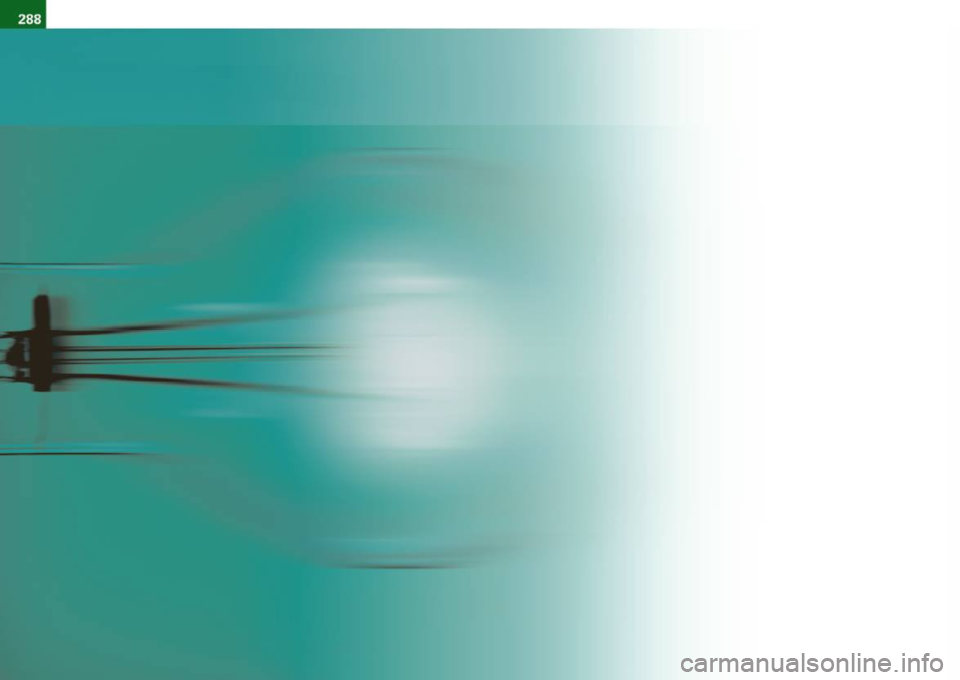AUDI A4 CABRIOLET 2009 Owners Manual
Manufacturer: AUDI, Model Year: 2009, Model line: A4 CABRIOLET, Model: AUDI A4 CABRIOLET 2009Pages: 340, PDF Size: 77.32 MB
Page 281 of 340

__________________________________________________ T_ ir_e _ s_ a_ n _ d_ w_ h_ e_ e_ls _ _____,ffllll
In correct wheel alignment
Inc orrect wheel alignment can cause excessive tire wea r, impairing
the saf ety of the vehicle . If tires s how excessive wear , have the
whee l alig nment chec ked by an autho rized A udi deale r or q ualif ied
workshop .
All Wheel Drive
Vehicles with quattro ® must always have tires of the same si ze ,
cons tructi on and tread type . For details see => page 218 .
& WARNING
Sudden tire failure can lead to loss of control, a crash and serious
personal injury!
• Never drive a vehicle when the tread on any tire is worn down
to the wear indi cators .
• E specially in wet and slick driving situations , a preferably large
profile depth of the tires is necessary , and an approximately
similar profile depth of the front and rear axle tire s.
• The diminished driving safety , caused by too small of a tire
profile , is negatively perceivable especially in handling , in danger
of hydroplaning when driving through deep puddles and ponds ,
when driving around curve s, and in braking behavior.
• Worn t ires are a safety hazard , they do not grip well on wet
roads and increase your risk of "hydroplaning " and loss of control.
• Always keep chemicals that can cause tire damage , such a s
grease , oil , gasoline and brake flu id away from tires.
• Tires age even if they are not being used and can fail suddenly ,
espe cially at high speeds . Tires that are more than 6 years old can
only be used in an emergency and then with special care and at
lowe r speeds.
• Never mount used tire s on your vehicle if you are not sure of
their "previous history ." Old u sed tires may have been damaged
even though the damage cannot be seen that can lead to sudden
tire failure and los s of vehicle control. •
New tires and replacing tires and wheels
New tires and wheels ha ve to be bro ken in.
Fig. 211 Tire spe cification cod es on the sidewall of a tir e
No. Description
©
@
@
@
©
©
Passenger car tire (where applicable)
Nominal w id th of tire in mi llimeters
Ratio of height to width (aspect ratio)
Radia l
ii Rim diameter code
Load index an d sp eed ra ting
Vehic le care irechnical data
Page 282 of 340

-~_T_ ir_e_ s_ a_ n_d _ w_ h_ e_e _l_s _________________________________________________ _
0
©
@
U.S. DOT tire identification number
Sever snow conditions
Tire ply composition and materials used
Maximum load rating
Treadwear, traction and temperature grades Maximum permissible inflation pressure
The tires and rims are essential parts of the vehicle's design. The
tires and rims approved by Audi are specially matched to the char acteristics of the vehicle and can make a major contribution to good
road holding and safe handl ing when in good condition and prop
erly inflated =>& .
We recommend that al l work on tires and wheels be performed by
an authorized Audi dealer . They are familiar with recommended
procedures and have the necessary special too ls and spare parts as
we ll as the proper facilities for disposing of the o ld tires .
Authorized Audi dealers have the necessary information about tech
n ical requirements for insta lling o r changing tires and rims .
Repl ac ing t ires and wheels
Tires should be replaced at least in pairs and not individually (for
example both front tires or both rear tires together).
On vehicles with tire pressure moni toring system*, be sure to read
and heed the information=>
page 287.
Always buy replace ment radia l tires tha t have the same specifica
tions as the tires approved for your vehicle by Audi . Replacement
tires must always have the same load rating specification as the
original equipment or approved optional tires listed in the table
=>
page 271.
A udi -appr oved specificat ion tires a re specially matched t o your
vehic le and its load limits, and can contribute to the important road- holding, driving characteristics, and safety of the vehicle
. T he tab le
( =>
page 271) lists specifications of the tires approved for the Audi
models covered by your Owner's Literature.
The tire pressure label located either on driver's side B -pi llar or
insi de the fuel filler flap(=>
page 271, fig. 208) lists the specifica
tions of the original equipment tires installed on your vehicle at the
time it was manufactured.
Federa l law requires tire manufacturers to place standardized infor
mation on the sidewa ll of all tires=>
page 279, fig. 211. This informa
tion identifies and descr ibes the fundamenta l characteristics, the
quality grade of the tire and a lso prov ides a tire identification
number for safety standa rd certif ication and in case o f a recall.
Tire sp ecifi cations
Knowledge of tire specifications makes it easier to choose the
correct t ires. Rad ial tires have the tire specifications mar ked on the
sidewal l, for example:
P235 / 45 R 18 95 Y
This c onta ins the fo llowing informatio n:
P Indicates the tire is fo r passenger cars (where appl icab le)
2 3 5 Nominal tire width in mm of the tire from sidewall edge to s ide -
wa ll edge. In general, the larger the number, the wider the tire
45 Height/width ratio in percent (aspect ratio)
R Tire construction: Radial
18 Rim d iameter c ode (in inches)
95 Load rat ing code
V Speed rating letter code
X L (or "xi", "EXTRA LOAD" or "RF") indicates that the tire is a "Rein
forced" or an "Ex tra Load" ti re
M +S (or "M/S") Indicates that the tire has some mud and snow capa
bility
The ti res cou ld also have the information of direction of rotation
=>
page 267 .
Page 283 of 340
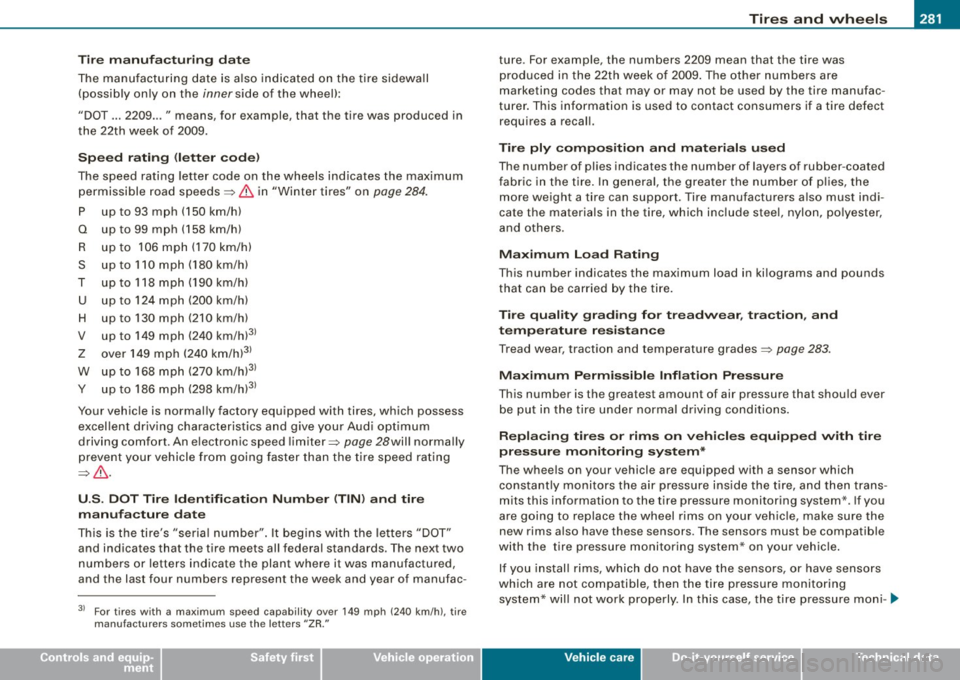
__________________________________________________ T_ ir_e_ s_ a_ n_d _ w_ h_ e_ e_l_s _ ...... ffllll
•
Tire manufacturing date
The manufacturing date is also indicated on the tire sidewall
(possibly on ly on the
inner side of the wheell:
"DOT ... 2209 ... " means, for example, that the tire was produced in
the 22th week of 2009.
Speed rating (letter code)
The speed rating letter code on the wheels indicates the maximum
permissible road speeds =:,
& in "Winter tires" on page 284.
P up to 93 mph (150 km/h)
Q up to 99 mph (158 km/h)
R upto 106mph(170km /h)
S upto110mph(180km/h)
T upto118mph(190km/h)
U up to 124 mph (200 km/h)
H upto130mph(210km/h)
V up to 149 mph (240 km/h)
31
Z over 149 mph (240 km/h)3
l
W up to 168 mph (270 km/h)31
Y up to 186 mph (298 km/h)3
l
Your vehicle is normally factory equipped with tires, which possess
excel lent driving characteristics and give your Audi opt imum
driving comfort. An electronic speed limiter=:,
page 28will normal ly
prevent your vehicle from going faster than the tire speed ratin g
=:>& .
U.S. DOT Tire Identification Number (TIN ) and tire
manufacture date
This is the tire's "serial number". It begins with the le tters "DOT"
and indicates that the tire meets all federal standards. The next two
numbers or letters indicate the plant where it was manufactured,
and the last four numbers represent the week and year of manufac-
31 For tires with a maximum speed capability over 149 mph (240 km/h), tire
m anufacturers so metimes use the letters "ZR."
ture. For example, the numbers 2209 mean that the tire was
produced in the 22th week of 2009. The other numbers are
marketing codes that may or may not be used by the tire manufac
turer . This information is used to contact consumers if a tire defect
requires a recall.
Tire ply composition and materials used
The number of plies indicates the number of layers of rubber-coated
fabric in the tire. In general, the greater the number of plies, the
more weight a tire can support. Tire manufacturers also must indi
cate the materials in the tire, which include steel, nylon, polyester,
and others.
Maximum Load Rating
This number indicates the maximum load in kilograms and pounds
that can be carr ied by the tire .
Tire quality grading for treadwear, traction, and
temperature resistance
Tread wear, traction and temperature grades=:, page 283.
Maximum Permissible Inflation Pressure
This number is the greatest amount of air pressure that should ever
be put in the tire under normal driving conditions.
Replacing tires or rims on vehicles equipped with tire
pressure monitoring system*
The wheels on your vehicle are equipped with a sensor which
constantly monitors the air pressure inside the tire, and then trans
mits this information to the tire pressure monitoring system*. If you
are going to replace the wheel rims on your vehicle, make sure the
new rims also have these sensors . The sensors must be compatible
with the tire pressure monitoring system* on your vehic le .
If you install rims, which do not have the sensors, or have sensors
which are not compatible, then the tire pressure monitoring
system* wil l not work properly. In this case, the tire pressure moni -.,_
Ve hic le care
Page 284 of 340
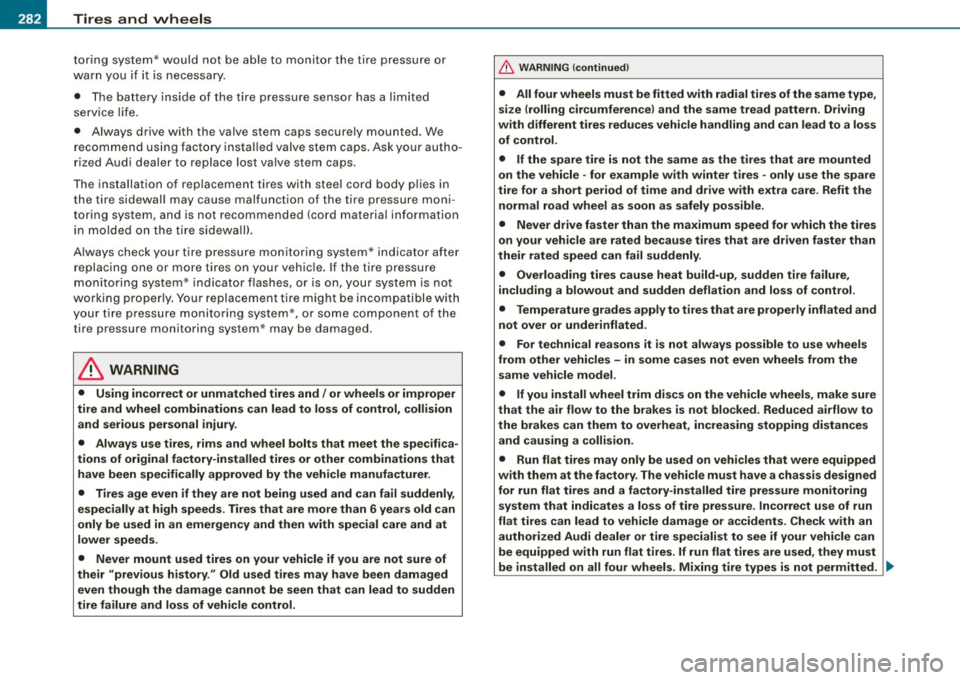
-~_T_ ir_e_ s_ a_ n_d _ w_ h_ e_e _l_s _________________________________________________ _
toring system* would not be able to monitor the tire pressure or
warn you if it is necessa ry.
• T he battery inside of the tire pressure sensor has a limited
service life.
• Always drive with the valve stem caps securely mounted. We
r ecommend us ing facto ry insta lled va lve stem caps. Ask you r autho
rized Audi dealer to replace lost va lve stem caps.
T he installation of rep lacement tires with steel cord body p lies in
t he tire sidewall may cause mal functi on of the tir e pressure mo ni
toring system , and is not recommended (cord material information
in mo lded o n th e ti re sid ewa ll) .
Always check your tire pressure monitoring system * indicator after
r eplacing one or mo re ti res on your veh ic le . I f the ti re p ress ure
m onito ring syste m* ind icator flashes, or is o n, your s ystem is not
wo rking properly . Your replacement t ire might be incompatible with
yo ur tir e pressure mon ito ring system* , o r so me compo nen t of th e
tire p ressure monitoring system * may be damaged .
& WARNING
• Using incorrect or unmatched tires and I or wheels or improper
tire and wheel combinations can lead to loss of control , collision
and serious personal injury .
• Always use t ires , rims and wheel bolts that meet the specifica
tions of original factory-installed tires or other combinations that
have been specifically approved by the vehicle manufacturer.
• Tires age even if they are not being used and can fa il suddenly,
espe cially at high speeds . Tires that are more than 6 years old can
only be used in an emergency and then with special care and at
lower speed s.
• Never mount used tire s on your vehicle if you are not sure of
their "previous history ." Old used tire s may have been damaged
even though the damage cannot be seen that can lead to sudden
tire f ailure and loss of vehicle control.
& W ARNING (continued )
• All four wheels mu st be fitted with radial tires of the same type,
size (rolling circumference ) and the same tread pattern. Driv ing
with different tires redu ces vehicle h andling and can lead to a loss
of control.
• If the spare tire is not the same as the tires that are mounted
on the vehicle - for e xample with winter tire s - only u se the spare
tire for a short period of time and drive with extra care . Refit the
normal road wheel as soon as safely possible.
• Never drive faster than the maximum speed for which the tires
on your vehicle are rated because tires that are driven faster than
the ir rated speed can fail suddenly .
• Overloading tires cause heat build-up, sudden tire failure ,
including a blowout and sudden deflation and loss of control .
• Temperature grades apply to tires that are properly inflated and
not over or underinflated .
• For te chnical reasons it is not always possible to use wheels
from other vehicle s -in some cases not even wheels from the
same vehicle model.
• If you install wheel trim discs on the vehicle wheels, make sure
that the air flow to the brakes is not blocked. Redu ced airflow to
the brakes can them to overheat , increasing stopping distances
and causing a collision.
• Run flat tire s may only be used on vehicle s that were equipped
with them at the fa ctory . The vehicle must have a cha ssis designed
for run flat tires and a factory -installed tire pressure monitoring
s ystem that indicate s a loss of tire pressure . Incorre ct use of run
flat tires can lead to vehicle damage or accidents . Check with an
autho rized Audi dealer or t ire specialist to see if your vehicle can
be equipped with run flat tires .
If run flat tires are used , they mu st
be installed on all four wheels . Mixing tire types is not permitted. .,
Page 285 of 340
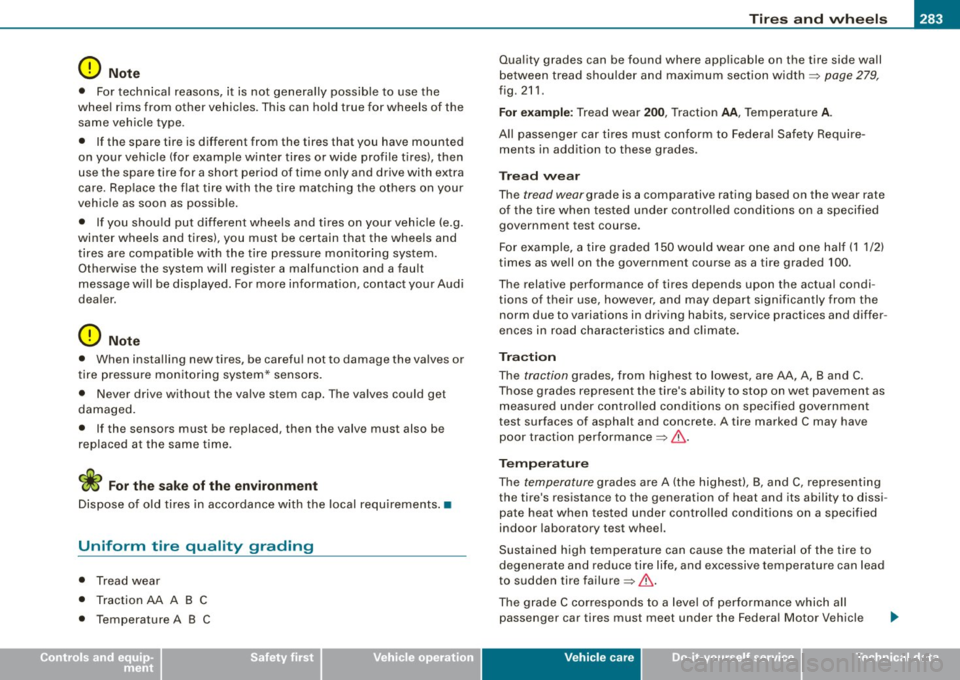
__________________________________________________ T_ ir_e_ s_ a_ n_d _ w_ h_ e_ e_l_s _ ...... fflll
•
0 Not e
• For technical reasons, it is not genera lly possible to use the
wheel rims from other vehic les. This can hold true for wheels of the
same vehicle type.
• If the spare tire is different from the tires that you have mounted
on your vehicle (for example winter tires or wide profile t ires), then
use the spare tire for a short period of time only and drive with extra
care. Rep lace the flat tire with the tire matching the others on your
vehic le as soon as possible.
• If you should put different wheels and tires on your vehic le (e.g.
winter wheels and tires), you must be certain that the wheels and
tires are compatib le with the tire pressure monitoring system.
Otherwise the system will register a malfunction and a fault
message will be displayed . For more information, contact your Aud i
dea ler.
0 Note
• When insta lling new tires, be carefu l not to damage the valves or
t ire pressure monitoring system* senso rs.
• Never drive without the va lve stem cap. The va lves could get
damaged.
• If the sensors must be replaced, then the valve must also be
replaced at the same t ime.
Uniform tire quality grading
• Tread wear
• Traction AA A B C
• Temperature A B C Qua
lity grades can be found where applicable on the tire side wall
be tween tread shoulder and maximum section widt h =>
page 279,
fig. 21 1.
For example : Tread wear 200, Traction AA , Temperature A.
All passenger car tires must conform to Federa l Safety Require
ments in addition to these grades.
Tre ad w ear
The tread wear grade is a comparative rating based on the wear rate
of the tire when tested under con trol led conditions on a specified
government test course.
F o r exam ple, a tire g raded 150 would wear one and one half (1 1/2)
times as well on the government course as a tire graded 100 .
The relative performance of tires depends upon the actual condi
tions of the ir use, however, and may depart significantly from the
norm due to variations in driving habits, service practices and differ
ences in road cha racteristics and c limate .
Tra ction
The traction grades, from highest to lowest , are AA, A, Band C.
Those grades represent the tire's ability to stop on wet pavement as
measu red under contro lled conditions on specified government
test surfaces of asphalt and concrete. A tire marked C may have
poor traction performance =>
/.1.
Temperatur e
The temperature grades are A (the highest), B, and C, representing
the tire 's resistance to the generation of heat and its ability to dissi
pate heat when tested under contro lled conditions on a specified
indoor laboratory test wheel.
Sus tained high temperature can cause the material of the ti re to
degenerate and reduce tire life, and excessive temperature can lead
to sudden tire failure=>
/.1.
The grade C corresponds to a level of performance which all
passenger car tires must meet under the Federal Motor Vehicle
Vehic le care
Page 286 of 340
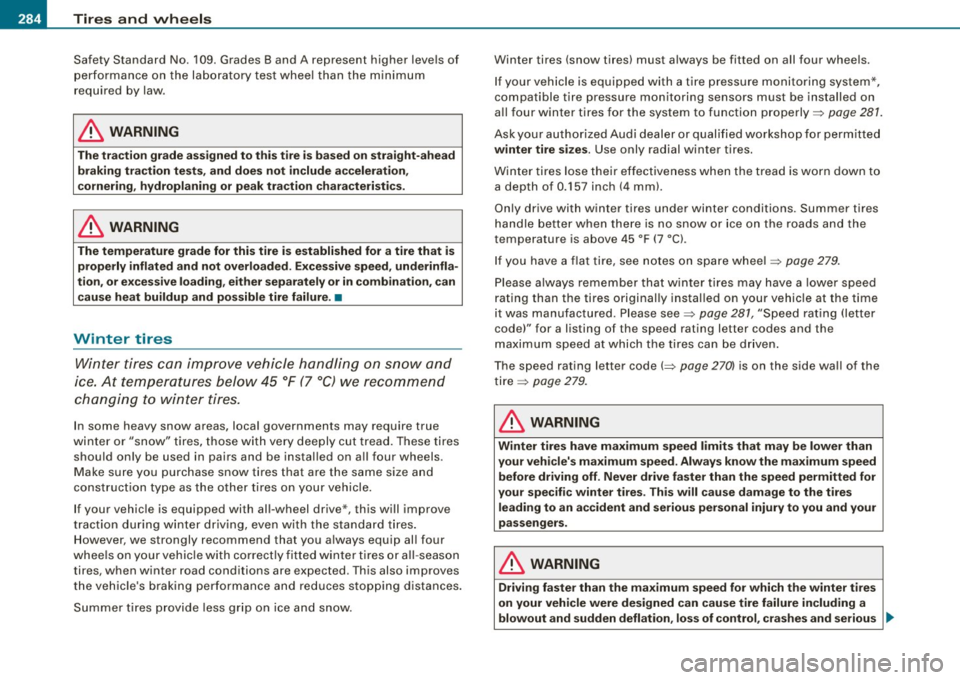
-~_T_ ir_e_ s_ a_ n_d _ w_ h_ e_e _l_s _________________________________________________ _
Safety Standard No. 109 . Grades Band A represent higher leve ls of
p er forma nce on th e laboratory test w hee l tha n the minim um
required by law .
& WARNING
The traction grade ass igned to this t ire is based on straight-ahead
braking traction tests , and does not include a cceleration ,
c ornering , hydroplaning or peak tra ction characterist ics .
& WARNING
The temperature grade for this tire is established fo r a tire that is
properly inflated and not overloaded. Excessive speed , underinfla
tion, or exces sive loading , either separately or in combination , can
cause heat buildup and possible tire failure . •
Winter tires
Winter tires can improve veh icle ha ndl ing on sno w and
ic e. A t tem peratures belo w 45 °F (7
°C ) w e rec omm end
c ha ng ing to wint er tir e s.
In some heavy snow areas, local governments may require true
winte r or "snow" tire s, those wi th ve ry deeply cut tread. These tires
should only be used in pairs and be instal led on a ll four wheels .
M ake s ure you p urchase snow ti res that are the same size and
cons truct ion type as the o the r ti res on your v ehicle.
I f your vehic le is equipped with al l-wheel drive*, this will improve
t raction during w inter dr iving, even with the s tandard tires .
H owever, we strongly recommend that you a lways equ ip all four
whee ls on y our vehic le wi th correc tly fitted winte r tires or all-seas on
tires, when winter road conditions are expected. This also improves
th e ve hic le 's brak ing performance and red uces s to ppi ng d ista nce s.
Summer t ires p rov ide less gr ip o n ice and s now. Winter tires (snow tires) must a
lways be fitted on all four whee ls .
I f your veh icle is equipped with a ti re pre ssure monitoring system*,
compatible t ire pressure mon itoring sensors must be installed on
a ll four winte r tires for the system to function properly ~
page 281.
Ask your aut hori zed Audi dealer or quali fied wo rksho p for perm itte d
winter tire sizes . Use only radial winter tires.
Winter tires lose thei r effec tive nes s when the tread is wo rn down t o
a depth of 0.157 inch (4 mm).
On ly drive with winter tires unde r winter conditions. Summer tires
h andle be tter w hen th ere is no s now o r ice on t he roads a nd the
temperature is above 45 °F (7 °C) .
I f you have a flat tire, see n otes on s pa re whee l~
page 279.
Please a lways remember that w inte r tires may h ave a lowe r speed
rating than the tires original ly instal led on yo ur vehic le at the time
i t was manu fac tured. Please see~
page 281, "Speed rating (letter
code)" for a listing of the speed rating letter codes and the
m ax imum speed at wh ic h th e tir es ca n be d riven .
The speed rating letter code(~
page 270) is on the side wa ll of the
ti re ~
page 279.
& WARNING
Winter tires have maximum speed limits that may be lower than
your vehicle's maximum speed . Always know the maximum speed
before driving off . Never drive faster than the speed permitted for
your specific winter tires . This will cause damage to the tires
leading to an accident and serious personal injury to you and your
pa ssengers.
& WARNING
Driving faster than the maximum speed for whi ch the winter tires
on your vehicle were designed can cause tire failure including a
blowout and sudden deflation , los s of control , crashes and seriou s
~
Page 287 of 340
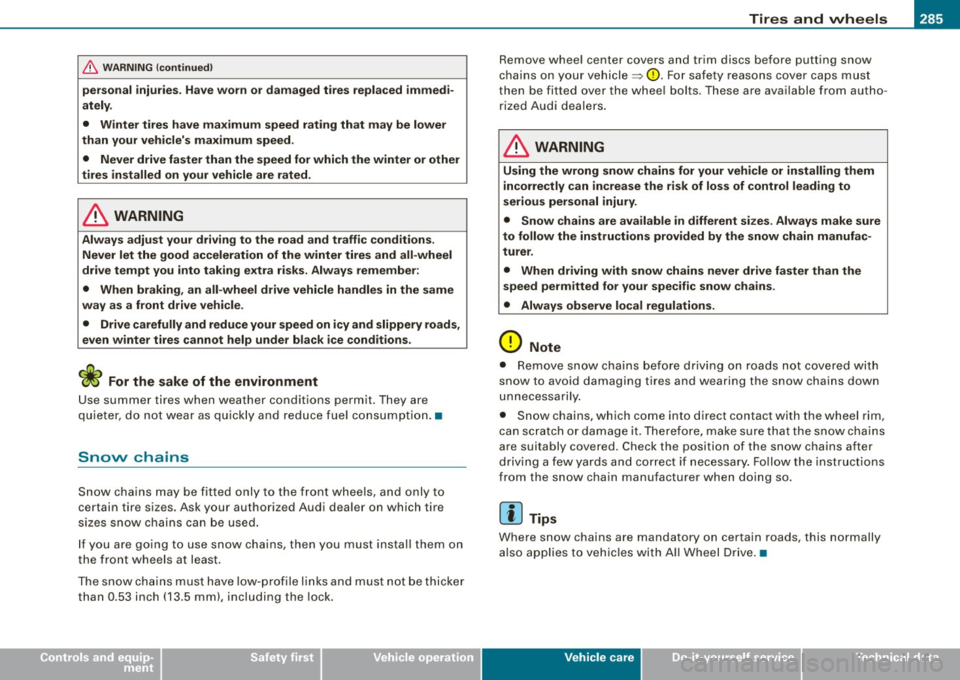
__________________________________________________ T_ ir_e_ s_ a_ n_d _ w_ h_ e_ e_l_s _ ...... 911
•
& WARNING (conti nued )
personal injuries . Have worn or damaged tires repl aced immed i
ately.
• Winter tires have ma ximum speed rat ing that may be lower
than your vehi cle' s maximum speed.
• Never drive faster than the speed for which the winter or other
tire s installed on your vehicle are rated.
& WARNING
Always adjust your driving to the road and traffi c cond it ions .
Never let the good acceleration of the winter tires and all -wheel
drive tempt you into taking e xtr a risks . Alway s remember :
• When braking, an all -wheel drive vehicle handles in the same
way as a front drive vehi cle.
• Drive carefully and reduce your speed on icy and slippery road s,
even winter tires cannot help under black ice condit ions .
<£> For the sake of the environment
Use summer tires when weather conditions permit. They are
qu ieter, d o not wear as qu ick ly and reduce fue l con sump tion.•
Snow chains
Snow chains may be fitted only to t he fr ont w heels, and only to
certain tire sizes . Ask your authorized Aud i dealer on which tire
s izes sn ow chains ca n be used .
I f you are going to use snow chains, then you must instal l them on
the front wheels at least.
Th e snow chains must have low- prof ile l inks and must n ot be t hicke r
than 0 .53 inch (13 .5 mm), including the lock. Remove whee
l center covers and trim discs before putting snow
chains o n yo ur vehicle =>
(D. For safe ty reaso ns cover caps must
then be fitted over the wheel bolts. These are available from autho
r iz ed Audi dealer s.
& WARNING
Using the wrong snow chain s for your vehicle o r installing them
incorre ctly can increase the risk of loss of control leading to
s erious personal injury .
• Snow chains are available in d iffe rent sizes . Always make sure
to follow the instructions provided by the snow chain manufac
turer .
• When driving with snow chains never drive faster than the
speed permitted for your specific snow chains .
• Always observe local regulations.
(}) Note
• Remove snow c hai ns be fore d riving on roads not covered wit h
snow to avoid damaging tires and wearing the snow cha ins down
unnec essarily .
• Snow chains, which come into direct contact with the wheel rim,
can scratc h or damage it. Therefore, make sure tha t the snow cha ins
are suitably covered. Check the position of the snow chains after
dr iv in g a few yards an d cor rect if necessary . Fo llow the i nstruct ions
from the snow cha in manufacturer when do ing so.
[ i ] Tips
Where snow chains are mandatory on certain roads, this normally
a lso a pplie s to veh ic le s wi th A ll Wheel D rive .•
Ve hic le care
Page 288 of 340

IIIJIL_T~ ir~e =s~ a~n~ d~ w~ h ~e~e~ l~ s '.,_ ______________________________________________ _
Wheel bolts
Wheel bolts must always be tightened to the correct
torque .
The design of wheel bo lts is matched to the factory installed rims . If
different rims are fitted, the correct wheel bolts with the right length
and correctly shaped bolt heads must be used. This ensures that
whee ls are fitted securely and that the brake system functions
correctly .
I n certain circumstances, you may not use wheel bolts from a
different vehicle -even if it is the same model~ page 318.
& WARNING
Improperl y tightened or maintained wheel bolt s can be come loose
c au sing lo ss of control , a co llis ion and seriou s personal injur y.
• Alwa ys keep the wheel bolt s and the th reads in the wheel hubs
c lean so the wheel bolt s can turn ea sily and be properl y tightened.
• Never gre ase or oil the wheel bolt s and the thre ad s i n the wheel
hub s. They can become lo ose while drivin g if gre ased or oiled ,
e ven if tig hten ed to th e specifi ed torque .
• Onl y use wheel bo lt s th at bel ong to the rim being in sta lled.
• Nev er use differ ent wheel s bolt s on your vehicle.
• Alway s m aintai n the corre ct t ightenin g to rq ue for the whee l
bo lt s to r edu ce the ri sk of a whe el los s. If the tighten ing torque of
t h e w heel bolt s is too l ow, they c an loose n a nd com e out when th e
v ehicl e is mov ing . If th e tighte ning torque is t oo high, the whe el
b ol ts an d threads can be dam ag ed and the whee l can become
loo se .
0 Note
The specified torque for the wheel bolts is 90 ft lb (120 Nm) with a
tolerance of ± 7,4 ft lb(± 10 Nm). Torque whee l bolts diagonally.
After changing a wheel, the torque must be checked as soon as possible with a torque wrench
-preferably by an authorized Audi
dea ler or qua lified workshop .•
Low aspect ratio tires
Your Audi is fac tory-equipped with low aspect ratio tires. These tires
have been thorough ly tested and been selected specifically for your
model for their superb performance, road feel and hand ling under
a variety of driving conditions . Ask your authorized Audi dealer for
more details.
The low aspect ratio of these t ires is ind icated by a numera l of 55 or
l e ss in the tire's size designation . The numera l represents the ratio
of the tire's sidewa ll height in relat ion to its tread w idth expressed
in percentage. Conventiona l tires have a height/width ratio of 60 or
more .
T he perform ance of lo w-as pect-rati o tire s is part ic ul arl y s ensit ive to
improp er infla tion pr essure. It i s there fore important that low
a s pect ra tio tir es are inflated to the sp ec ified pre ssure an d th at th e
i nfl ation pre ssure is regularl y checked and m aintained . T ir e pres
s ure s should b e checked a t lea st once a month and alw ays before a
long trip~ page 274, "Checking tire pressure".
What you can d o to avoid tire a nd rim dama ge
Low aspect ratio tires can be damaged more easi ly by impact with
potho les, curbs, gull ies or ridges on the road, particularly if the tire
is underinflated.
In order to minimize the occurrence of impact damage to the tires
of your vehic le, we recommend that you observe the fo llowing
precautions:
• Always maintain recommended inflation pressures . Check your
tire pressure every 2,000 miles (3,000 km) and add air if necessary .
• Drive careful ly on roads with potholes, deep gullies or ridges.
The impact from driving through or over such obstacles can
damage your tires. Impact with a curb may also cause damage to
your tires . .,_
Page 289 of 340
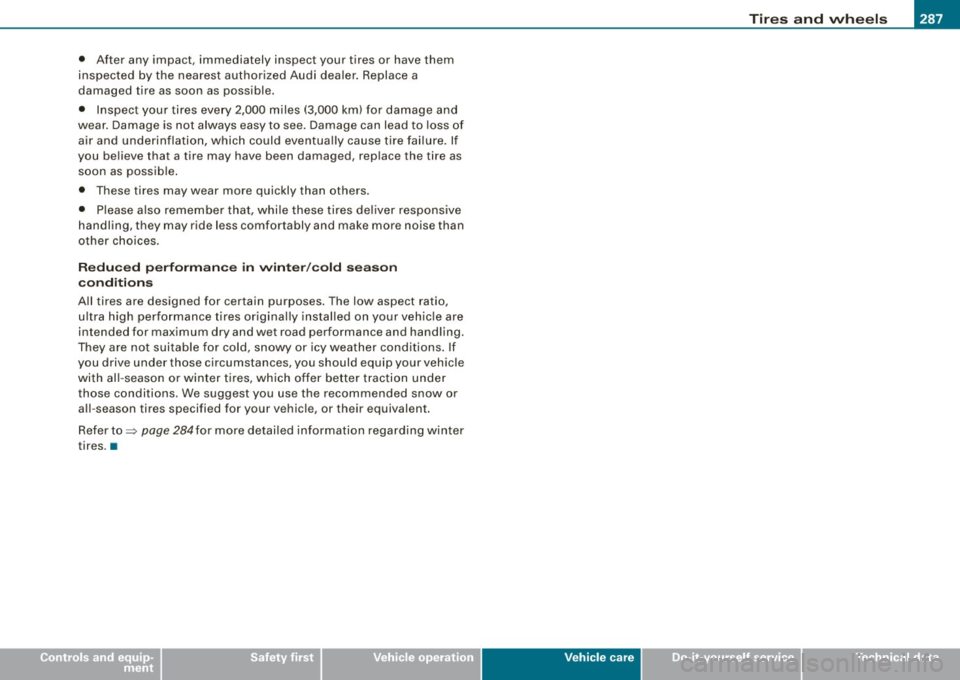
__________________________________________________ T_ ir_e_ s_ a_ n_d _ w_ h_ e_ e_l_s _ ...... 11111
•
• After any impact, immediately inspect your tires or have them
inspected by the nearest authorized Audi dealer. Replace a
damaged tire as soon as possible .
• Inspect your tires every 2,000 miles (3,000 km) for damage and
wear. Damage is not always easy to see. Damage can lead to loss of
air and underinflation, which could eventua lly cause tire failure. If
you believe that a tire may have been damaged, replace the tire as soon as possible .
• These tires may wear more quickly than others .
• Please a lso remember that, while these tires deliver responsive
handling, they may ride less comfortably and make more noise than
other choices.
Reduced performance in vvinter /cold season
conditions
All tires are designed for certain purposes. The low aspect ratio,
ultra high performance tires originally installed on your vehicle are
intended for maximum dry and wet road performance and handling.
They are not suitable for cold, snowy or icy weather conditions. If
you drive under those circumstances, you should equip your vehicle
with all -season or win ter tires, which offer better traction under
those conditions . We suggest you use the recommended snow or
all -season tires specified for your vehicle, or their equivalent .
Refer to=>
page 284for more detailed information regarding winter
tires. •
Vehic le care
Page 290 of 340
